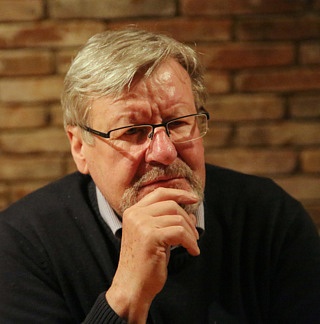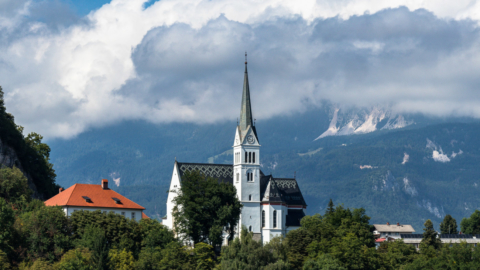updated March 13, 2017
Moravia, in the Czech Republic, is a fascinating wine region. Behind the Iron Curtain until the Velvet Revolution of 1989, winemakers did not have the freedom to indulge in creating a style, but rather most were forced to grow grapes for the communist “people’s wine” as dictated by the soviet government.

Hanging out with a Miroslav, a delightfully funny winemaker who opened up maybe 20 different bottles of wine.
Winemaker Miroslav Volařík of Vinařství Volařík jokes “we couldn’t try other wines, so we didn’t know how terrible ours was. We didn’t know the difference.” Vineyards in this southeastern region of the country are new, a result of having to pull out the too-close-together crops of the socialist era. Grapevines have been replanted in the last 20 years to provide proper spacing so they can breathe and grow and not have to share their earthy resources, which used to thin and dilute their eventual juice.
But now winemakers like Miroslav and Radomír Nepraš of Vinařství Nepraš have their land back and are free to make the kind of wine they are proud of, the kind of wine that expresses the terroir – the land, the sun, the hillsides and the spirit – of the Moravian people. Quite often it’s a white wine, a Riesling or a varietal of the Burgundy region like a Chardonnay or a Pinot Gris. But as winemakers move forward with modern techniques, and experiment with Pinot Noir, Merlot, and a local grape called Rulandské Modré more reds are emerging that have an interesting peppery, almost dusty profile.

Tasting in the Nepras family cellar with Ludmilla and my husband Seamus.
I had a chance to spend the day with Ludmila Nepraš trying wines throughout the region from Palava to Bořetice to Mikulov and learn more about the region. Starting in the Nepraš family cellar in Pavlov, I met her husband Radomír, a winemaker in Moravia since 1966, and had the opportunity to taste some of his wines and talk to him in-depth about the region.
1) What grapes grow best in Pavlov? What type of wines do you make at Nepraš and Co.?
Palava and Pavlov especially is a very interesting site, thanks to both the soil composition and microclimate conditions. The quality of wines from Pavlov is significantly influenced by the presence of metamorphosed Ernstbrunn limestone with a high content of manganese and magnesium, which occurs only here. The wines here are very mineral and salty. Soil reaction is alkaline and therefore the whole Burgundy family flourishes here, e.g. Pinot Gris, Pinot Blanc, Chardonnay, Pinot Noir, very interesting wines are Sauvignon Blanc, but the most valuable variety is Welschriesling, giving here totally extraordinary interesting, crystallitic wines with a vernal acid.
2) Who in your family is involved in making wine and what do they do?

Andrew Veselý runs the tasting room at the family winery in Pavlov.
We are a family winery, so all the family members are involved and active. My son Andrew is the oenologist and a managing director; he manages the daily operation in the vineyards and in the cellar.
My wife Ludmila takes care of the sales and relationships with our customers and Andrew’s girlfriend Teresa, as a journalist, is responsible for media presentation of the winery and our e-shop.
As the current needs and seasonal works require, we employ local men and women. And I try to kindly oversee everything and to create the best possible conditions for our work for us all, thanks to my long-lasting relationships within the winemaking community.
3) How long have you been making wine and how has that changed over the years?
I made my first wine in 1966 as a hobby. Gradually I gained more and more experience, but until the fall of the communist regime in 1989, the production of wine was under a state monopoly, and because of the isolation of our country the national viticulture developed only very slowly.

Radomír Nepraš, a winemaker in Moravia, Czech Republic talks about his role in bringing Czech wines back to popularity in Europe and beyond.
After the revolution, there was a very quick turnaround, both in terms of the access to modern processes and technologies and the formation of a group of wine lovers, who started to strongly influence the attitude and direction of the local winemaking. Also, the consumption of wine increased dramatically and almost doubled in the past 16 years.
For me, there was also a dramatic change, because in 1999 I turned my life inside out like a glove and became a winemaker leaving my past career of an architect behind. I established the prestigious winery Reisten, which belonged to the best in the country. In 2012 I sold my shareholding in this winery and founded the family winery Nepraš & Co, in which I put all my previous experience. I am pleased by my son Andrew, who studied winemaking at the universities in our country and in Germany, and is now doing on a scientific basis what I was doing out of passion.
4) How you do you see Moravia’s wine region changing over the next decade?
I believe that the Moravian wineries will soon again become an important component of the European viticulture, where they have always belonged. The phenomenon of the northern wines, defined by the 48th parallel, is gaining more and more supporters and admirers. A perfect example is a steadily increasing popularity of Grüner Veltliner from Austria on the US market. Moravian wines are very close to the Austrian wines and often surpass them. For example, Sauvignon, Riesling, Welschriesling, the family of Burgundy wine gives here a quite exceptional quality – the wines are very vernal and have an exciting acid bouquet. Worth noting is also the new local varieties such as Palava, Moravian Muscat or Hibernal. The wine lovers will also be certainly surprised by the superior quality of red Moravian wines.
I am currently a member of the working group preparing the transition to the appellation system that is intended to generate the best wines from the Moravian production. Currently we are using the German model of the wine classification, which is based on the content of the sugar in the grapes at the time of the harvest. In our country, where artificially irrigated vineyards are practically non-existent and therefore the vine is looking for moisture in considerable depths, the soil composition and microclimatic conditions create a unique terroir.
In the New World, where most vines are under irrigation, the root system of vines lies just a few inches below the surface and the influence of the soil here is not very much relevant. Therefore, the European model with multiple atomized wineries with vineyards between 5-10 hectares are providing a plethora of wines that uniquely represent the winemaker who creates them. For wine lovers, Europe and Moravia are a boundless source for finding new experiences.

Seamus and I trying some of Moravia’s white wines in the vineyards that front the Palava hills.
5) What is one of your biggest challenges or obstacles?
The challenges are there to be accepted and overcome. Our goal is to produce wines that will represent the unique character of their origin and our respect for the magnificent landscape and nature we live in. All our vineyards are treated in an organic process, and therefore our wines are labeled as organic. The winery is a constant, very personal dialogue with nature and the road to this mutual understanding is certainly incorporated in our wines.
- White wine grapes starting to grow in the Palava Hills, Czech Republic.
- The Nepraš family winery in Pavlov, in southeast Czech Republic.
- The whole Nepraš family plays a part in keeping the cellar running smoothly.
6) Have you lived in Pavlov your entire life? What do you like most about it?
My original profession led me to different places in the world, I was even part of the creation of the Hudson River Greenway at Battery Park in New York. But I am attached to Pavlov and its hills where I am truly at home.
This is the place where 32 thousand years ago began the shaping of the world culture. From the period of Gravettian came the first attempts of the artistic creation in the history of mankind. At that time, the places where lie our vineyards represented one of the most populated areas in Europe. From there comes the ceramic statuette The Venus of Věstonice and many other important archaeological artifacts. For millennia, this place possesses a massive “genius loci” which we intensively perceive and which we want to share with others in our wines.
7) What advice would you give a visitor planning a trip to Moravia’s wine region for the first time? Where should they go to taste wine?
Pavlov is a hospitable place, popular every year, not only by wine lovers but also by those who are passionate about history. Numerous wine cellars offer the visitor a unique view of the traditional European winemaking. There are several hotels and guesthouses and the gallery of Pavlov wines, where visitors can taste the best wines from this area.

The Southeastern Pálava hillsides are covered with hundreds of hectares of vineyards. The limestone in the soil makes this terroir and the wines very specific and nice, especially the Welsh Riesling. Source: Ludmila Nepraš
Pavlov is surrounded by a necklace of vineyards and wine villages. The nearby Mikulov is an urban monumental area, and the nearby Lednice – Valtice cultural landscape is on the UNESCO World Heritage list. In Moravia, other nearby places worth noticing are Znojmo, Dolní Kounice or the area near the city of Kyjov.
****
Below is our trip visit list. We stayed in the town of Mikulov, though you might also want to think about staying in the Lednice-Valtice area near the castle as well. If you do visit Moravia, you’ll definitely want to bring back as many wines as you can, since distribution in other countries, especially the US is extraordinarily limited to nonexistent.
How to Plan a Visit to Czech Wine Country
Sleep
In Mikulov – Apartmany Gulliver
In Lednice – Hotel Mario
In Valtice – Penzion Valtice or Chateau la Veneria
*Note, for some of the above, the sites are in Czech. You can book most of these through your favorite booking engine. I typically use Booking.com.
Eat
In Mikulov – Sojka and Spol (excellent vegetarian options)
In Pavlov – Hotel Pavlov
Do
In Mikulov – Visit Mikulov Castle
In Lednice-Valtice – Wander the gardens and explore the sumptuous Chateau of the Lednice-Valtice Complex, a UNESCO world heritage site.
Wine Tasting
In Mikulov – Vinařství Volařík
In Pavlov – Nepras and Co., Gotberg Winery, Sonberk Winehouse
In Lednice-Valtice – visit the National Wine Centre
Transport
Nearest Airport Brno–Tuřany Airport, 45 minutes by car
Vienna International Airport, 1 hour, 15 minutes by car
Prague International Airport, 3 hours by car
For train and buses try Czech Transport
Speak
Hello – Dobrý den (DOH-bree den)
Goodbye – Na shledanou (na SCHLE-da-noh)
Please – Prosím (PROH-seem)
Thank you – Děkuji (Djeh-koo-ee)













7 Comments